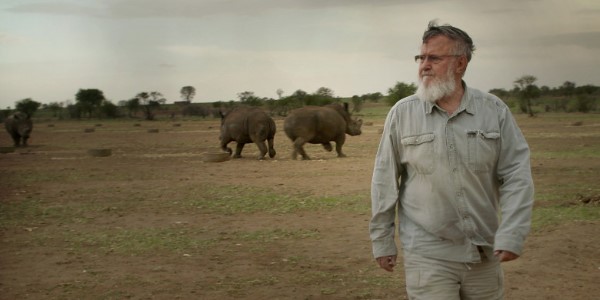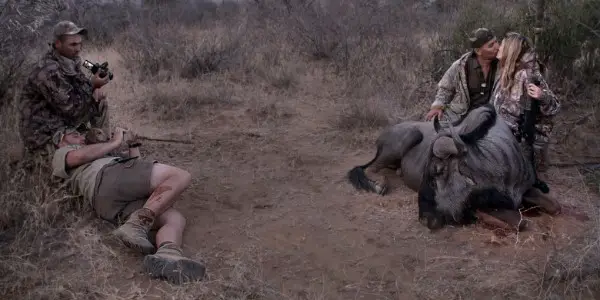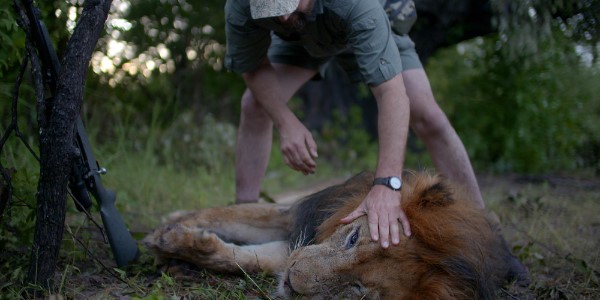TROPHY: Objectivity Through A Killer Lens

Musanna Ahmed is a freelance film critic writing for Film…
There’s a scene in Trophy where American recreational hunter Philip Glass visits an anti-hunting rally and confronts some of the activists with reasons for why his favoured activity isn’t murder. Both sides go back and forth at each other and the conversation ends as if it didn’t start, their views solidly set in stone. For folks who are going to engage in the future’s conversations about hunting, I don’t imagine their discussions will be of a similar obstinate nature once they’ve seen Trophy.
In fact, their discussions will be much more productive and undogmatic because of Trophy’s detailed approach to exploring the trades of big-game hunting, breeding and wildlife conservation in Africa and the United States, taking us around hunting hotspots including Texas, Nevada, Namibia and South Africa.
Taking aim from all sides
Trophy’s approach is to thoroughly observe the industry from various standpoints. The four principal ones belong to; the aforementioned Philip Glass, who justifies his stance by saying that the Bible states that God gave man dominion over animals so humans have an eternal leeway to hunt, Zimbabwean wildlife officer and anti-poacher Chris Moore who states with a tired sincerity that “We can’t lose our humanity for humanity”, pro-hunting money-minded South African safari owner Christo Gomes, who professes to love animals, and another South African, the most fascinating of the four, former property developer and now rhino breeder John Hume.

Hume owns the world’s largest rhino form, containing over 1500 rhinos. His intentions for conservation are noble but actions are controversial – he cuts the horns of rhinos to repel poachers and breeds the rhinos in his farm. He wants to financially sustain this method of preserving the extant status of the species by appeasing the other side and selling them the multi-million dollars’ worth of rhino horn that he’s stored – the only problem is that rhino horn trade is illegal.
The scenes of his legal fight to legalize the sale of rhino horns in South Africa is depicted and so is the horn-cutting process, every excruciating second of it. Though it’s hardly the most difficult thing to watch in a film where we also explicitly see lions and elephants hunted and their gleeful hunters posing for photographs over their dead bodies. There’s only a tiny possibility that the genuine euphoria they experience upon shooting an animal dead is being played up or down for the camera – the thrill of the kill is real.
The scenes of these killings are breath taking, in both the intensity of their content and the remarkable skills displayed by the crew. The actuality footage that the Trophy team have captured is exceptional, evident straight from the opening as we join Glass and his son in an intimate scene of them hunting zebra. The filmmakers are always at the right place at the right time, which is typically when the ill-fated animals aren’t. It’s hard to look away when the view of animals being stunned is so stunning.
Brutal and beautiful
Knowing the potential criticisms co-directors Shaul Schwarz and Christina Clusiau may receive for their unfiltered, graceful handling of the footage, I’m reminded of Hacksaw Ridge and the criticisms Mel Gibson received for his elegant craft of the most brutal scenes. If Gibson’s intent was to make an anti-war film, appropriate to the attitude of his pacifist protagonist Desmond Doss, then why is the awful violence so elegant? For me, the point of the beautifully filmed violent scenes in Trophy and Hacksaw Ridge is to necessarily depict the extreme circumstances that the subjects (here, the animals) are placed in to try and survive.

The reasons for why it’s necessary in Trophy are a little harder to figure out than the uncomplicated intents of Hacksaw Ridge. With Trophy, the filmmakers have attempted to create an objective account of the hunting industry by respecting all sides and providing them enough time (the documentary runs for a discernibly lengthy 108 minutes) and space to air their opinions. The glaring hints of which side the filmmakers’ sympathies are with can be found in the periodic statistic titles that show the declining number of various species. But there’s no solution suggested.
Mixed feelings and difficult answers
This is understandable considering the scale of the poaching crisis. Hume’s security advisor and rhino custodian Li Lotriet even suggests that a war is needed to solve the conflict between poachers and anti-poachers. Even Philip Glass’ jubilation of hunting is tested when he starts sobbing after a big-game hunt. It’s entirely possible that they’re tears of joy because he’s now a fifth of the way closer in his quest to complete the Big Five (lion, elephant, rhino, leopard and buffalo). Likewise, the affordable time for the principal characters provides sufficient time to witness Gomes have a moment of being shaken to his core when thinking about the animals and, like Glass, his sincerity is questionable.
The personal feelings and considered arguments of the hunters and anti-hunters alike, for how to protect local citizens, how to protect the land, and of course how to protect animals from extinction provide so much food for thought that Trophy is practically a restaurant of viable arguments. You may be a firm subscriber to a specific idea, and I’m not suggesting the other side deserves sympathy, but Trophy is absolutely worth the watch to review what you think should be done regarding the tough topics of hunting, breeding and conservation. Especially when the filmmakers don’t offer any distinct solutions.

I recommend Trophy for that reason but perhaps a bigger reason for why I recommend it to see an excellent visual piece of documentary filmmaking. When the steady cameras aren’t carefully composed in shooting the shootings, they’re on dollies, sliders and in the air to maintain the high production values and strengthen the storytelling through very fine compositions from several remarkable angles. It resembles the best of fictional filmmaking with its splendor and none of it feels self-congratulatory either. It may be that a lack of answers means that Schwarz and Clusiau may not have succeeded as activists, but they’ve certainly succeeded as filmmakers.
Trophy: Conclusion
Striking imagery and defences that are both reasoned and provocative from a myriad of perspectives make Trophy a documentary that demands to be seen in the cinema. The power of the dark auditorium to command an audience’s best concentration span is essential to getting the most out a documentary where the filmmakers really want you to see their footage, and really want you to have a nuanced understanding of the subject at hand.
Which important subjects would you like to have a similar, detailed and fair documentary film treatment in the manner of Trophy?
Trophy is out now in the USA. It will be released in the UK on the 17th of November. More release dates here.
Does content like this matter to you?
Become a Member and support film journalism. Unlock access to all of Film Inquiry`s great articles. Join a community of like-minded readers who are passionate about cinema - get access to our private members Network, give back to independent filmmakers, and more.
Musanna Ahmed is a freelance film critic writing for Film Inquiry, The Movie Waffler and The Upcoming. His taste in film knows no boundaries.













